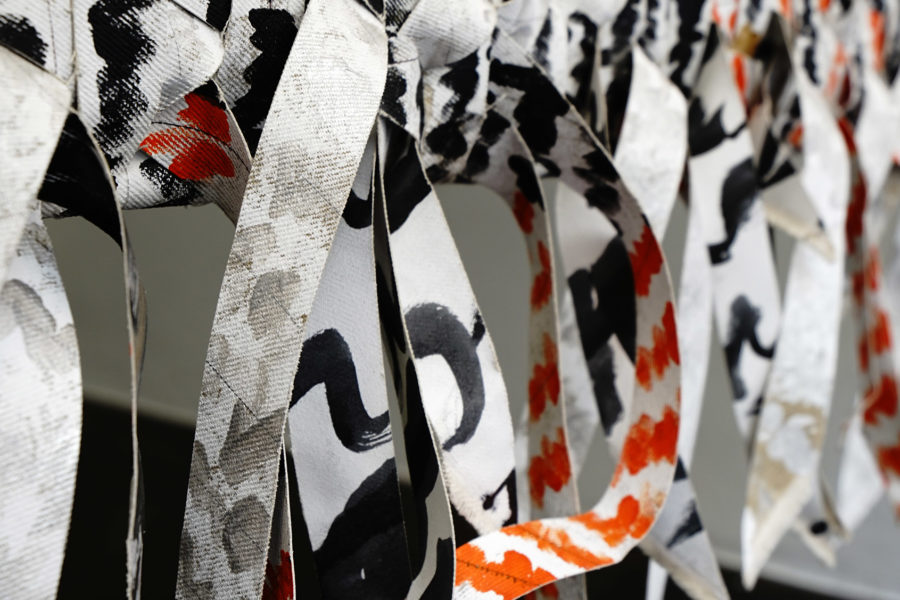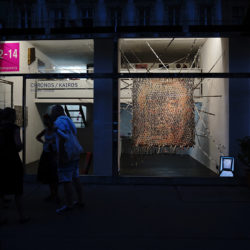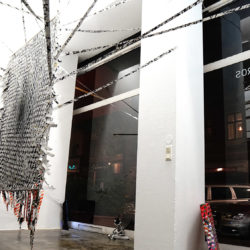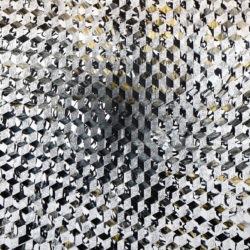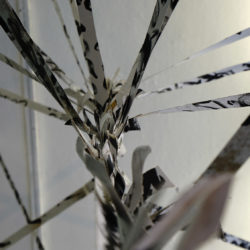CHRONOS KAIROS
Description
@12-14 Contemporary, Vienna/Austria
La poesía del Samurai antimonumento
Chronos / Kairos , la obra del artista japonés Shinpei Takeda se presenta por primera vez en Viena, en la galería Schleifmühlgasse 12-14. La pieza tiene como punto de partida la pintura, pero va mas allá, los lienzos de Shinpei no se muestran como las imágenes clásicas de una pintura en la pared o en su caballete: la obra comienza desde lo mas bajo, para llegar a lo mas alto de un espacio dado. Takeda pinta sentado en el piso, luego lleva su pintura a la cintura y de ahí empieza a tejer. El artista menciona: -Tejer y tejer, mis antipinturas son lienzos cortados tres veces, se unirán por medio de un tejido que mezcla la técnica tradicional mexicana y la japonesa.- Sus antipinturas se presentan como tridemensionales y invitan el publico a una búsqueda. Cada persona encontrara algo diferente, algunos un rostro otros simplemente símbolos y algunos mas descubrirán una poesía pictórica que los transportará a un estado de paz interior. Shinpei Takeda logra que sus piezas absorban al publico al interior de la obra misma, para encontrar un refugio de paz. Sus antipinturas tienen varias capas y sus lienzos muchas veces se cruzan, sin alguna búsqueda de perfeccion, para llevarnos a ver la poesía del samurái del antimonumento. Oscar SanchezThe search for the loss of time and the lost memories
Chronos / Kairos, the actual project by the Japanese artist Shinpei Takeda, will be presented in Vienna at Schleifmühlgasse 12-14 for the first time. Shinpei Takeda is well known for his site specific huge string installations and for his projects about Hiroshima and Nagasaki or with refugees in San Diego. He is a wanderer cross ethnicities and countries, born in Japan, raised in Germany, educated in US. Actually he is living and working between Japan, Mexico and Germany and he has exhibitions around the world. The starting point of the art work was pure painting, a skill he has not used for a couple of years. He worked in his studio in Düsseldorf and decided to create an hybrid project between already done art work and site specific display. He painted the sound frequencies from the interviews he had done of his Nagasaki / Hiroshima and Dresden Projects. In these projects he consulted survivers of the bombardment of Dresden and an atomic bomb survivor from Nagaski, who lives as an artist in Mexico. There were 3 portraits, one self portrait, one from Nora and one from the Japanise-Mexican artist, which he has deconstructed, cut. Referring to Japanese and Mexican handycraft, he began to weave and unite 3 faces in one. Cut-up technique is an aleatory literary technique in which a text is cut up and rearranged to create a new text. The concept can be traced to the Dadaists of the 1920s and has since been used in a wide variety of contexts. Related to the cut-up technique by the Dadaists and popularized in the 50ties by William Bourroughs, Takeda weaves a new portrait out of the stripes. But he does not give the text a new meaning, he transfers the words into a type of visuals. Kind of translation from one media to another while shifting the context as well as the content. Memories of different people are linked with ethnical and traditional influences, connected on different levels of diverse dimensions. In contrast to his string installations, the vibrations of his drawing lines are more dimensional – the weaving adds a level of interpretation. Like by-products, some images emerged, oscillating between craftsmanship and contemporary art, like a souvenier from his travels. Using the global creation of craft combined with global branded distinctive marks Shinpei Takeda offers communication as a important tool, which seems to fall into oblivion. The urge for reflection and contextualization is an obvious skill of the artist, the influence of different countries and live styles a sur plus. A necessity to work out memories of ourselves as well as common memories like history, which also influence our live style and behavior. The artist´s intention to find the intersection of objective time and subjective time develops parallel to the intersection of memories or/and subjective coloured interpretation of history. Denise Parizek, 2017Info







